How to Select Cloud HR vs On-Premises HR Software for Your Business
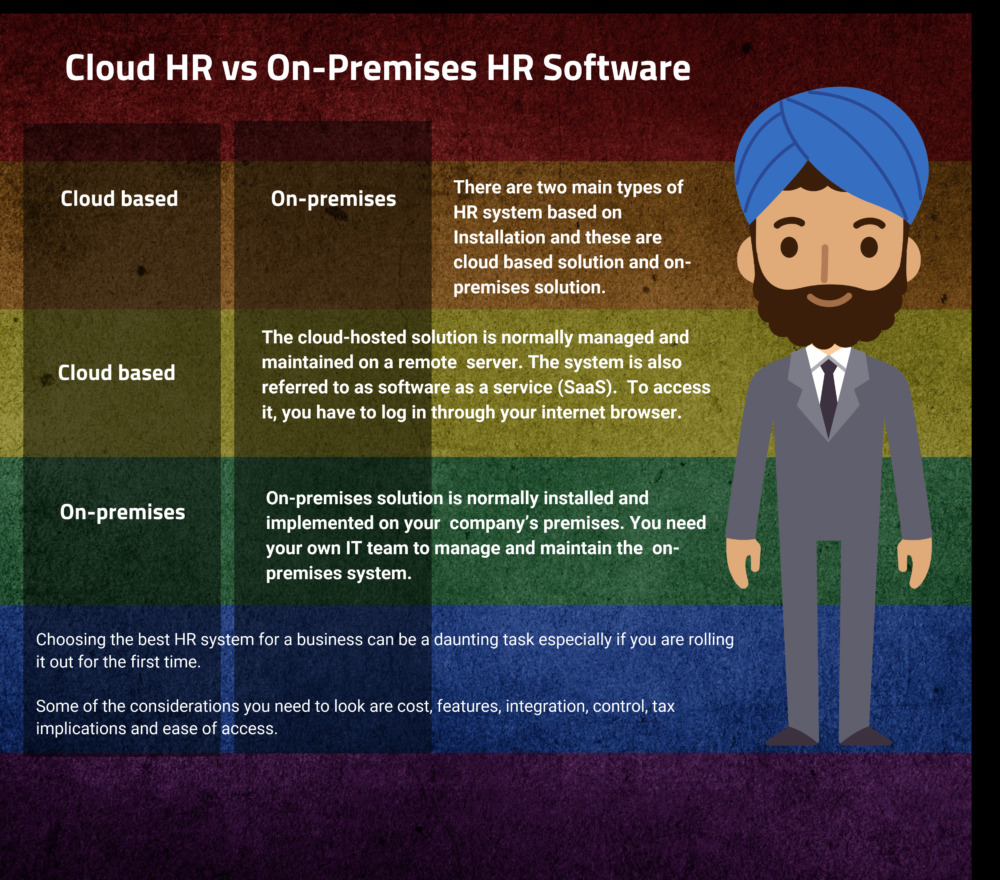
When planning to automate HR system most businesses are faced with the question of what type of system to adopt based on Installation. Basically, there are two main types of HR system based on Installation and these are cloud based solution and on-premises solution.
The cloud-hosted solution is normally managed and maintained on a remote server. The system is also referred to as software as a service (SaaS). To access it, you have to log in through your internet browser. Cloud computing rests on the pillars of shared resources and network access to offer low-cost and on-demand rapidly provisioned resources. An on-premises solution is normally installed and implemented on your company’s premises. You need your own IT team to manage and maintain the on- premises system.
Human Resource Management System should help an organization integrate all the core functions of HR in one platform. The solution should have modules such as payroll management, performance and appraisal management, rewards and benefits, recruitment and employee on boarding, and time and attendance management.
Choosing the best HR system for a business can be a daunting task especially if you are rolling it out for the first time. The following questions should assist you to make a decision on the best solution to settle on:
- What is the cost of installing the software?
- Which is the fastest to set up?
- Between the two, which is the most reliable?
- Which is the most secure?
Other considerations that you should look at are; integration, control, tax implications and ease of access.
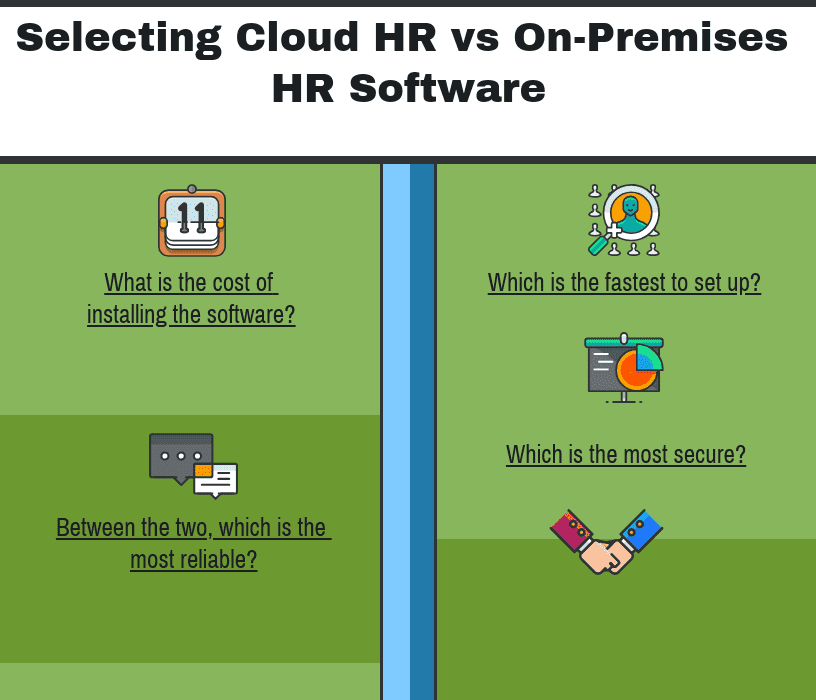
Selecting Cloud HR vs On-Premises HR Software
You may like to read: Top Core Human Resource Management Software (Core HR) and How to Select the Best Human Resource Software for Your Business
Benefits on Selecting Cloud HR vs On-Premises HR Software
Despite the glaring differences between cloud-based and on-premises HR solutions, both systems have an equal share of benefits. It all depends on the needs of your organization. Each organization has unique needs and some are best solved by cloud-based software while others are better sorted out by on-premises software.
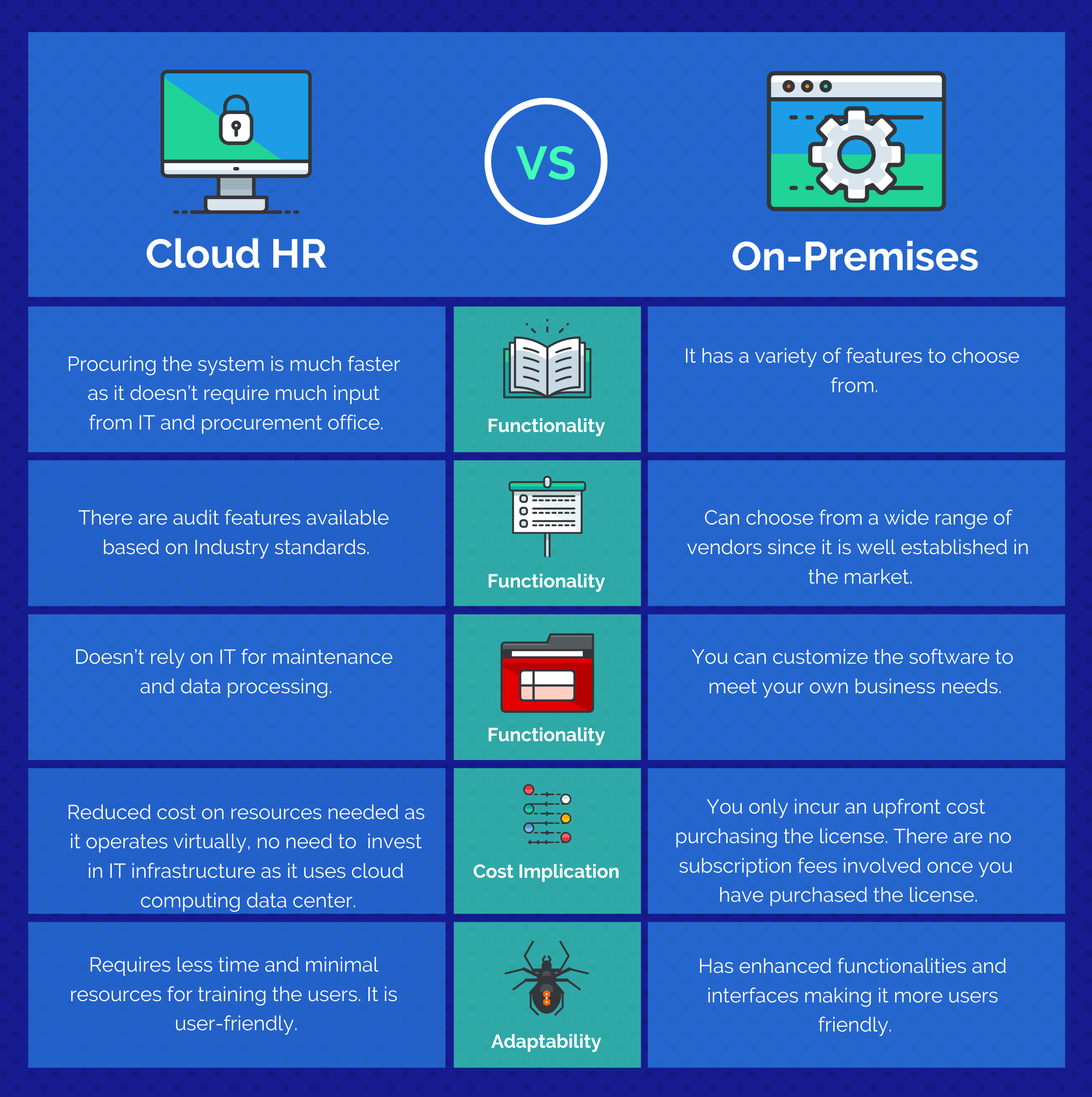
Benefits on Selecting Cloud HR vs On-Premises HR Software
Benefits | Cloud-based HR | On-premises HR |
| Functionality | Procuring the system is much faster as it doesn’t require much input from IT and procurement office. There are audit features available based on Industry standards. Has a self-service portal thus reducing the workload on HR staff. Doesn’t rely on IT for maintenance and data processing. | It has a variety of features to choose from. Can choose from a wide range of vendors since it is well established in the market. You can customize the software to meet your own business needs. You are assured of data security since data is stored in-house with restricted access to third parties. |
| Cost Implication | Reduced cost on resources needed as it operates virtually, no need to invest in IT infrastructure as it uses cloud computing data center. You are able to do away with maintenance, upgrade and customization cost. | You only incur an upfront cost purchasing the license. There are no subscription fees involved once you have purchased the license. |
| Adaptability | Requires less time and minimal resources for training the users. It is user-friendly. | Has enhanced functionalities and interfaces making it more users friendly. |
You may like to read: Top Human Resource Software for Small Business and Top Free and Open Source Human Resource (HR) Software
Disadvantages on Selecting Cloud HR vs On-Premises HR Software
Both systems have drawbacks which could cause havoc in your organization if not well thought. It all depends on what your organization needs and the level of operation. For instance, a large organization with a high number of employees might find cloud-based system unsuitable.
The organization might be in need of frequent updates and customization which is not likely to augur well with the system. On the other hand, a small company might find the same system more appropriate since the cost of installation is lower as opposed to having on-premises HR system.
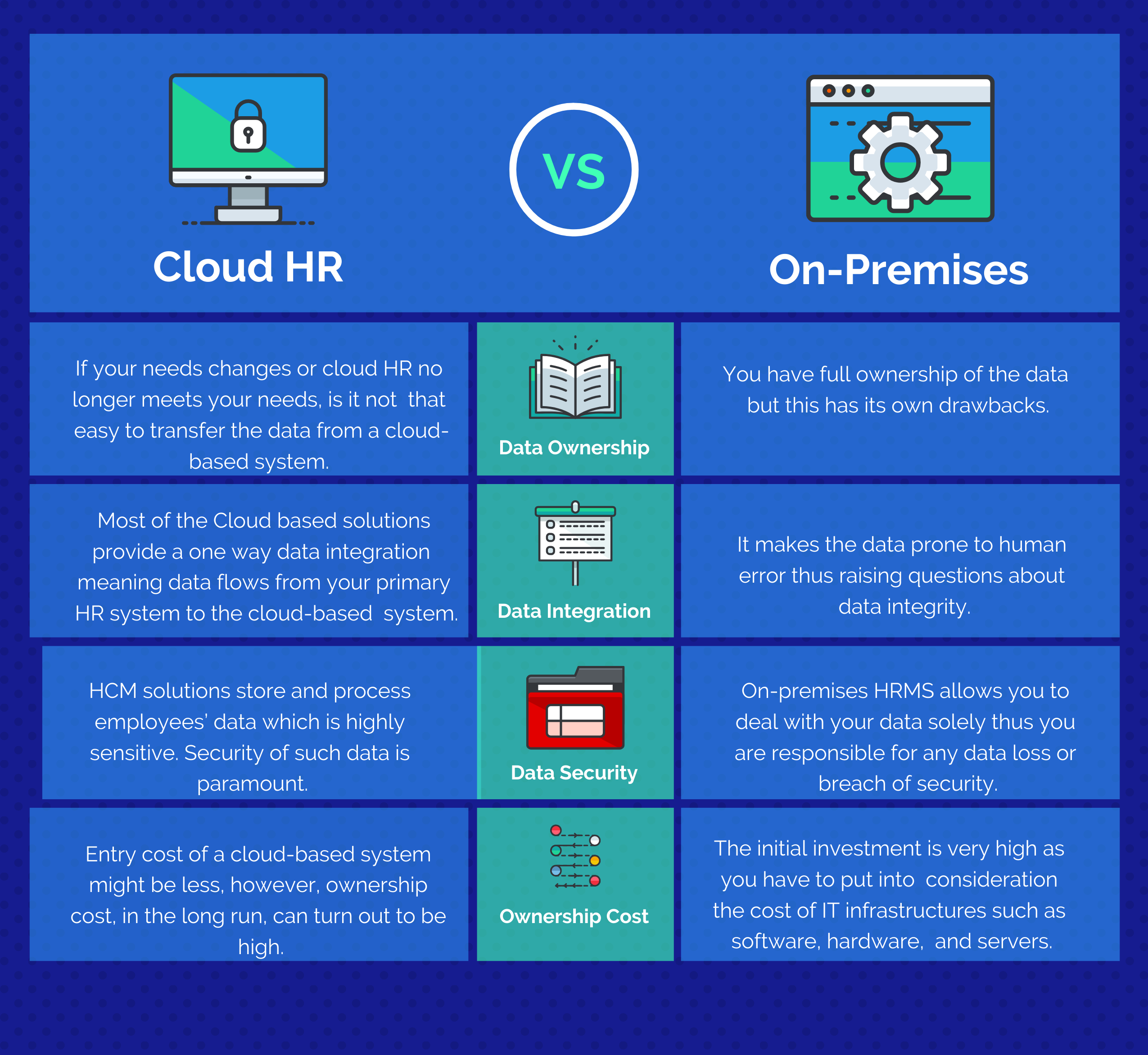
Disadvantages on Selecting Cloud HR vs On-Premises HR Software
Disadvantages | Cloud HR | On-premises HR |
| Data Ownership | If your needs changes or cloud HR no longer meets your needs, is it not that easy to transfer the data from a cloud-based system. Extracting data from the cloud-based system in order to move it to another solution is a bit difficult. As an organization, you don’t have full ownership of the data meaning you cannot extract it as you wish, the way you like. | You have full ownership of the data but this has its own drawbacks. Anyone can access the data and extract information that is deemed private and confidential if the security access are not defined properly. |
| Data Integration | Most of the Cloud based solutions provide a one way data integration meaning data flows from your primary HR system to the cloud-based system. You may end up creating disparate solutions which are not fully integrated. As a result, an organization will end up with two or three versions of data which might create confusion. | On-premises solution relies on manual data entry from different users. The same case applies to data updates. It makes the data prone to human error thus raising questions about data integrity. You might have different departments capturing different data for the same employee. This results in a messy and unreliable data which consumes time to verify. |
| Data Security | HCM solutions store and process employees’ data which is highly sensitive. Security of such data is paramount. Cloud-based HCM solutions are prone to data security breaches. Hackers can have access to the stored data thereby comprising the security of data stored. | On-premises HRMS allows you to deal with your data solely thus you are responsible for any data loss or breach of security. For this system to work for you, you need to have a sound security and data backup system in place. This is an added cost especially if you are strained on your budget. |
| Ownership Cost | Entry cost of a cloud-based system might be less, however, ownership cost, in the long run, can turn out to be high. You have to pay a monthly subscription fee to your vendor if the system is to keep running. | The initial investment is very high as you have to put into consideration the cost of IT infrastructures such as software, hardware, and servers. You also need IT team that will be there throughout to monitor and maintain the system. |
You may like to read: Top Human Resource Software for Small Business and Top Free and Open Source Human Resource (HR) Software
Tips on How to Choose between Cloud HR vs On-Premises HR Software
Deciding on the type of HR solution you want to settle for can be a bit confusing. Despite being the most popular HRM system in the market, they both have a set of positive and negative attributes. It is important to understand the advantages and disadvantages associated with each system before deciding on which one to settle for.
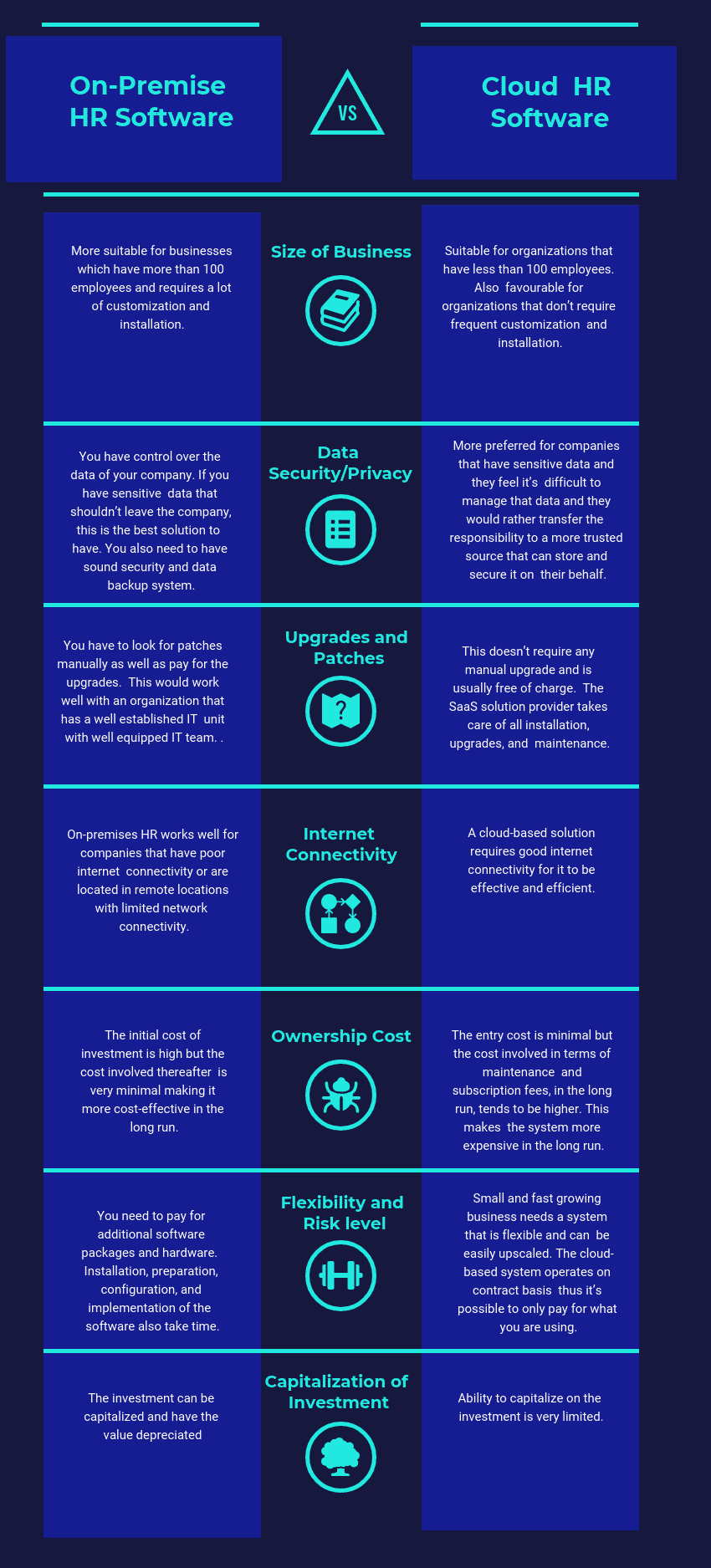
Tips on How to Choose between Cloud HR vs On-Premises HR Software
The table below captures some of the points to consider before making a decision.
Consideration | On-premises HR | Cloud HR |
| Size of Business | More suitable for businesses which have more than 100 employees and requires a lot of customization and installation. | Suitable for organizations that have less than 100 employees. Also favourable for organizations that don’t require frequent customization and installation. |
| Data Security/Privacy | You have control over the data of your company. If you have sensitive data that shouldn’t leave the company, this is the best solution to have. You also need to have sound security and data backup system. | More preferred for companies that have sensitive data and they feel it’s difficult to manage that data and they would rather transfer the responsibility to a more trusted source that can store and secure it on their behalf. |
| Upgrades and Patches | You have to look for patches manually as well as pay for the upgrades. This would work well with an organization that has a well established IT unit with well equipped IT team. Mostly, the upgrades are done during working hours thereby interfering with normal operations of the business. | This doesn’t require any manual upgrade and is usually free of charge. The SaaS solution provider takes care of all installation, upgrades, and maintenance. The exercise is done after office hours to avoid the distraction of workflow. Suitable for companies that don’t have a dedicated IT team. |
| Internet Connectivity | On-premises HR works well for companies that have poor internet connectivity or are located in remote locations with limited network connectivity. | A cloud-based solution requires good internet connectivity for it to be effective and efficient. |
| Ownership Cost | The initial cost of investment is high but the cost involved thereafter is very minimal making it more cost-effective in the long run. | The entry cost is minimal but the cost involved in terms of maintenance and subscription fees, in the long run, tends to be higher. This makes the system more expensive in the long run. |
| Flexibility and Risk level | You need to pay for additional software packages and hardware. Installation, preparation, configuration, and implementation of the software also take time. | Small and fast growing business needs a system that is flexible and can be easily upscaled. The cloud-based system operates on contract basis thus it’s possible to only pay for what you are using. |
| Capitalization of Investment | The investment can be capitalized and have the value depreciated | Ability to capitalize on the investment is very limited. |
The type of HRIS solution you implement should have an operational efficiency and business growth. Organizations should choose a system that will accelerate HR productivity while at the same time improving employee engagement.
Here are the trending and the top rated HR Software SMB for you to consider in your selection process:
You may like to read: Top Core Human Resource Management Software (Core HR) and How to Select the Best Human Resource Software for Your Business
What is Cloud based HR Software?
The cloud hosted HR solution is an HR system which is managed and maintained on a remote server. The system is also referred to as software as a service (SaaS). To access it, you have to log in through your internet browser. Cloud computing rests on the pillars of shared resources and network access to offer low-cost and on-demand rapidly provisioned resources.
What is on-premise HR Software?
The on-premises HR solution is an HR system, which is installed and implemented on your company’s premises. You need your own IT team to manage and maintain the on- premises system.
What are the benefits in Cloud-based HR?
The benefits in Cloud-based HR include procuring the system is much faster as it doesn’t require much input from IT and procurement office. There are audit features available based on Industry standards and has a self-service portal thus reducing the workload on HR staff. It doesn’t rely on IT for maintenance and data processing and many more.
What are the benefits in On-premises HR?
The benefits in On-premises HR include selecting from a wide range of vendors since it is well established in the market, customize the software to meet your own business needs and data security since data is stored in-house with restricted access to third parties and many more.
What are the factors to choose between Cloud HR vs On-Premises HR Software?
The factors to choose between Cloud HR vs On-Premises HR Software include Size of Business, Data Security/Privacy, Upgrades and Patches, Internet Connectivity, Ownership Cost, Flexibility and Risk level and Capitalization of Investment.































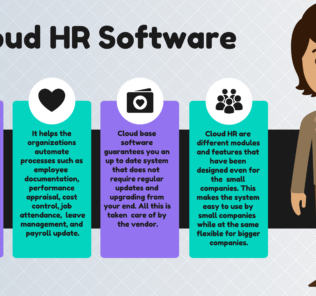
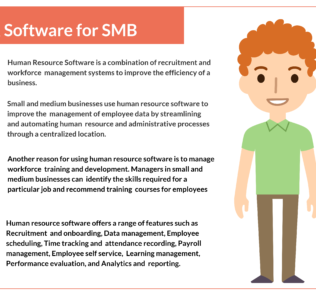







By clicking Sign In with Social Media, you agree to let PAT RESEARCH store, use and/or disclose your Social Media profile and email address in accordance with the PAT RESEARCH Privacy Policy and agree to the Terms of Use.